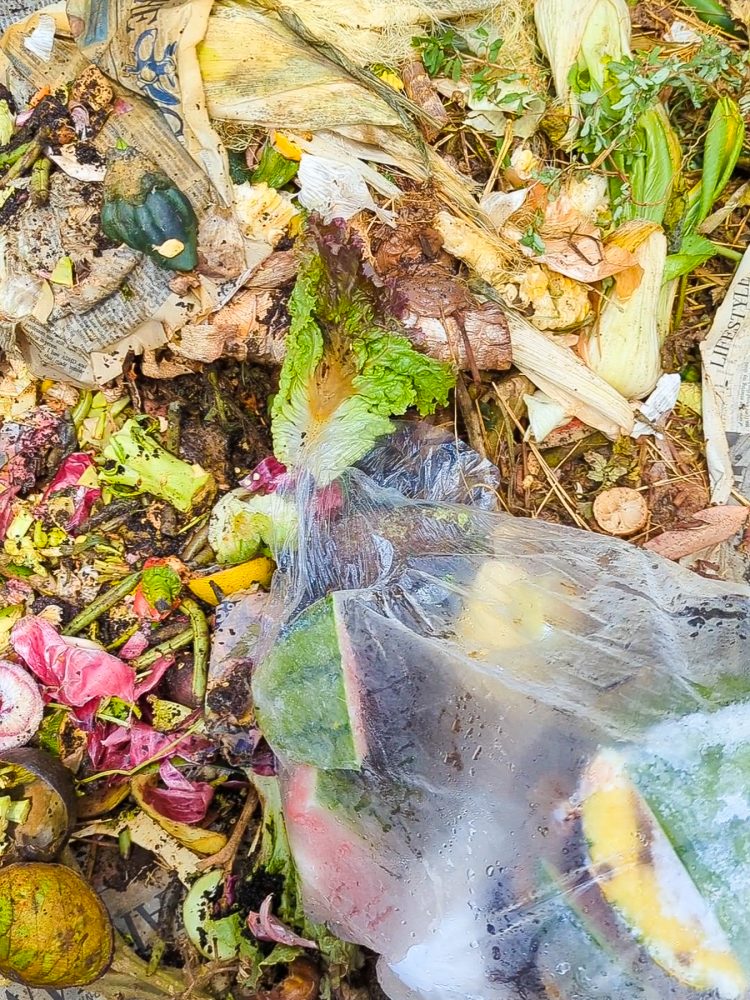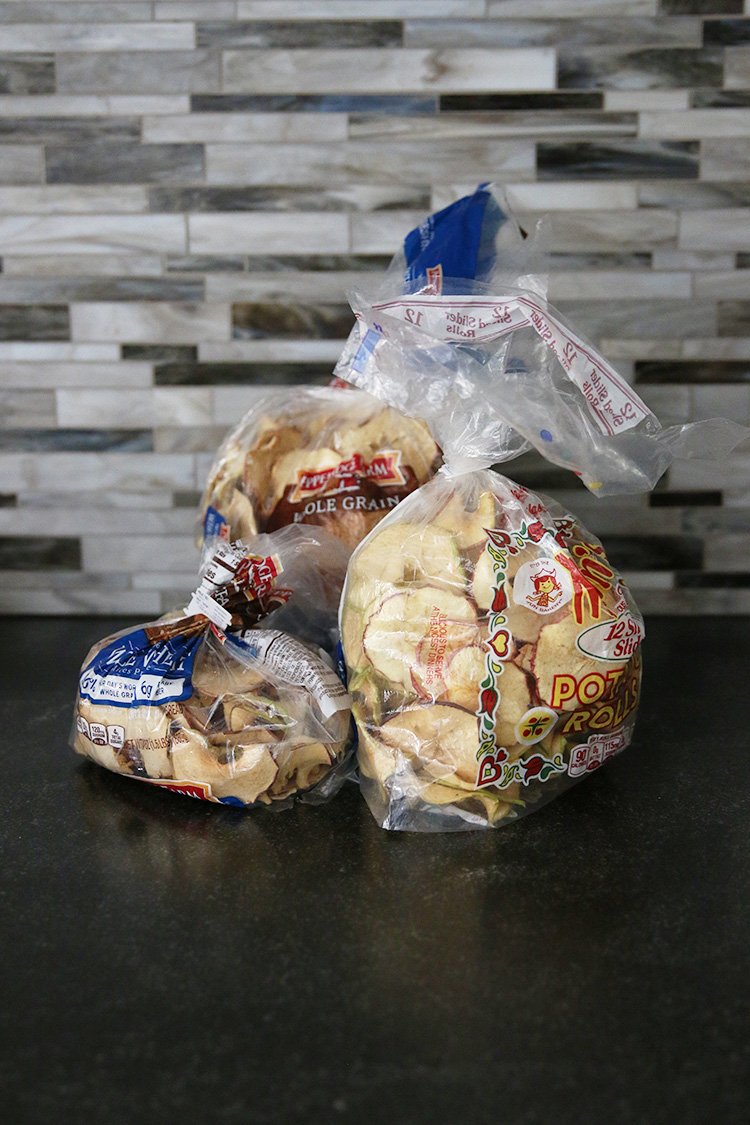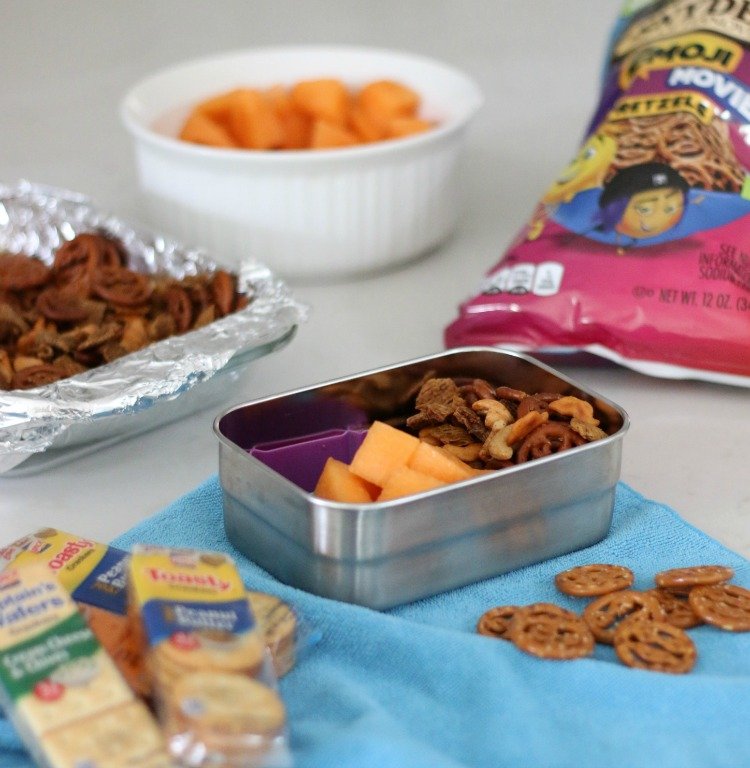5 Ways To Compost While Traveling + FAQ For Composting On The Road
Have you ever composted while traveling? Come along with me while we break down how to compost while traveling and show you what it actually looks like to use each of these composting options on the road.

If you compost at home, you know that a composting habit is hard to break! Once you start throwing all your food scraps into a compost waste stream instead of a landfill-bound bin, it’s cringeworthy to put food scraps in the trash. So what do we do when we’re on vacation and don’t have access to our home composting system?
Composting while traveling isn’t as easy as composting at home, but it’s certainly possible for many circumstances. Over the last few years, we’ve composted while on vacation in a few different ways depending on where we are, the transportation we used, and what is accessible in a particular location.

5 Ways To Compost While Traveling
If you’re on the road and want to sustain your green composting habit, here are five ways to compost while traveling. For each one, I’ve included a few more details about how composting on the road actually looked for us when we did it and answers to some frequent questions about composting while traveling more generally.

1. Drop Scraps at a ShareWaste Host Location
ShareWaste is probably the most widely-accessible solution for composting while traveling with respect to the variety of places this is available and the volume of scraps you can easily compost at one time. Our second option, municipal composting programs, is likely the easiest to use if it’s available. But in most locations, it’s not a robust part of city infrastructure just yet. Fingers crossed that changes in the future!
What is ShareWaste?
ShareWaste is an app on smartphones and tablets that connects compost hosts with compost donors. Compost hosts are people or organizations with compost bins and systems who are willing to accept food scraps from others to add to their bins. Compost donors are those with food scraps who want to compost them but can’t do it themselves and seek a place to drop their food scraps.
Compost hosts register with ShareWaste to add the location of their compost bin to the global map maintained by ShareWaste. Hosts share their location and terms of acceptance (what types of things they can and cannot take in their bins).
Compost donors search ShareWaste for hosts in their area and drop scraps at available composting sites. Donors can reach out to hosts through the messaging function on ShareWaste so there is no need to exchange personal information.


Where does ShareWaste operate?
ShareWaste works all over the world. ShareWaste is just an app for connecting composting enthusiasts. It’s only as good as the community that chooses to use it, so you can find places to compost anywhere a compost host has signed up to accept organic waste.
Does ShareWaste cost anything to use?
Nope! ShareWaste is free to use as a host and a donor. I use ShareWaste as both a host and a donor. I am a host at home and a donor while traveling.
What does using ShareWaste to compost while traveling look like in practice?
Over the summer, we rented a house in San Diego for a week to spend time with family. We made almost all of our meals at the house. During and after each meal, we saved our food scraps in the freezer in a couple of repurposed bread bags. On a previous trip, I used a large bowl in the freezer to collect food scraps.
See the Frequently Asked Questions About Composting While Traveling below for more ideas on how to store food scraps for composting while on the road.
Using ShareWaste, we found a local community garden that accepted food scraps for their compost bin. I messaged with the organization through the ShareWaste app to get information about where to put the food scraps before stopping by the garden. Once we got there, we learned they also had good signage, but I wanted to be sure we knew what to do with the food scraps before we showed up.
At the end of the trip, we drove to the community garden just before leaving town to drop off our food waste. We dumped the scraps, put the bread bags in the trash, and were on our way. It was so easy.
If there is a ShareWaste collection site nearby (and they are located all over the world), it’s surprisly simple to gather food scraps and drop them at established community composting sites. Often times, there is extra freezer space to house food scraps if you’re staying in a rental home.

2. City Compost Program
Some cities have their own robust composting programs. San Francisco, California, is a leader in this space with a mandatory recycling and composting ordinace, and other cities and towns are following suit.
To the extent available, it’s really easy to use compost bins much like the trash and recycling bins already available in many public spaces. Unfortunately, these aren’t as widespread as we might like. But they can make it much easier to compost while traveling when we don’t have access to our home compost bins, collection services, and the like.
When we traveled to San Francisco last summer, my boys loved seeing compost receptables in the airport as soon as we arrived. Only children of a mother who owns a curbside composting business get excited about that, right?
Most of the food vendors in the airport used compostable containers and utensils. The bins are readily available. And they typically have signage on them to help you know what goes in which bins.

3. Local Store Disposal Bins
A growing number of stores and fast casual restaurants have compost bins alongside trash and recycling bins, especially in places instituting composting ordinances. While you might not bring in large buckets of food scraps to compost in these bins (or at least I would feel hesitant doing that), you could definitely drop scraps from a meal or two here and there.
Throughout my travels, I’ve seen them in places like Whole Foods, certain McDonalds, Chipotle, and other similar types of restaurants. You will likely find them at places like food co-ops too, as these spots are often well aligned with environmentally-friendly policies and practices.

4. Bring Scraps Home With You
If you’re enjoying a road trip and have a bit of extra space in your vehicle, consider saving your scraps in a container like a 5-gallon bucket and bringing them home (if you compost at home) or dropping them at a ShareWaste site on the way home. We use 5-gallon buckets to collect food scraps for WasteWell, and they contain odors and mess really well as long as the lids are snapped on tightly.
A couple of years ago, we visited Lake Placid with friends. We drove to our travel destination from our home in Philadelphia. We had enough extra space in our vehicle to carry along one 5-gallon bucket for food scraps.
When we arrived at the rental home, I set the bucket in the dining room and then eventually under the counter in the kitchen so it was easily accessible. We were traveling with friends who didn’t compost at home, so I was responsible for composting for the most part. But our friends appreciated the opportunity to learn more about composting and reduce their waste while traveling.
If you do plan to transport your food scraps back home, you could freeze them while on your trip and pack them up just before leaving. This will reduce the amount of time the scraps have to break down before you get home, but it’s not necessary.
Also, be sure the bucket lid is sealed tightly and you store it in a place during travel where it won’t tip over or leak. Composting isn’t gross, but old, wet food scraps floating around in your car are not ideal, as I’m sure you can imagine.
5. Bury Food Scraps in a Hole
For travel to more remote areas, you may be able to bury your food scraps. Composting is nature’s recycling process, so the microorganisms in the soil will break down the food scraps over time.
Be sure to dig a solid hole that’s at least a food deep and cover it with plenty of dirt so the scent doesn’t attract animals. Most human food is not native to areas where we travel, so it’s not appropriate for the animals who live in the area.
Furthermore, leaving rotting food in areas with lots of humans encourages animals to seek out those areas and become more comfortable living in areas with lots of humans. This often isn’t great for the animals. It puts them in harms way from circumstances like traffic and also creates safety issues for humans (which ultimately leads to safety issues for the animals).
When done properly, burying food scraps is a perfectly fine way to compost food scraps and reduce waste. But if you plan to use this method, be sure to do so responsibly.

Frequently Asked Questions about Composting While Traveling
If you’re compost curious, here are a few more answers to common questions about composting while traveling and our recent experience composting on a family vacation.
Did you compost all the food waste you created?
No. We did not compost all the food waste from any of our trips. Most ShareWaste hosts don’t accept all types of food waste so there are certain items we put in the trash. Also, I want to be sure that composting feels easy and doesn’t become a drag on the trip. I’ll never encourage others to compost at home on their own if it feels burdensome even when I’m leading the effort.
I typically only compost produce scraps and sometimes a few bread products, depending on what’s allowed by the ShareWaste host. Scraps from meat and dairy go into the trash.
Even if the composting site accepts these types of organic waste, they get pretty gross fairly quickly (faster than produce), and I don’t want to spoil the experience. I want composting to feel accessible and achievable for anyone with me, so I try to stick to the easy stuff.
Tackling new elements of sustainable living is much easier if we take small, approachable actions first. Composting some food waste is better than nothing. And creating new habits with imperfect execution is far better than attempting perfection from the beginning.
How did you collect the food scraps for composting?
During meal prep and clean-up, we kept a bowl on the counter to gather scraps. For odd and ends we generated outside of meal times, I occasionally added them to the bags in the freezer as needed. Other times, we tossed food in the trash in order not to make composting a production for the trip.

Where did you keep the food scraps during the trip?
At the end of the meal, I transferred all the scraps into repurposed bread bags that we stored in the freezer until the end of the trip. Then we drove the food scraps to a community garden, registered as a host in ShareWaste, which was not far from our rental home.
How did you find a place to compost while traveling and know where to bring the food scraps?
I searched for a location nearby our rental home using the ShareWaste app the day after we arrived. I wanted to confirm early in the trip that we had a home for the food scraps before saving them. If we were going to send them to the landfill anyway, it would be silly to store them throughout the week.
I reached out with questions early on in our trip to give the host plenty of time to answer before stopping by to dump our food waste. It took them a couple of days to respond, so I was glad I didn’t wait until the last minute to inquire about location and host details.
Did other people traveling with you compost too?
Yes and no. On all of our trips, I did most of the work (i.e. took the initiative to get food scraps into the collection bucket or bag). Some others helped in varying degrees while still others had little interest in being involved at all.
My intentions are always to drive the process and leave opportunities open for people to participate where they’d like. During meal prep and clean-up times, I left a bowl on the counter to collect food waste. Sometimes others added scraps and sometimes I collected them and put them in the bowl. At the end of the meal, I added the contents of the bowl to the bread bags in the freezer so they didn’t smell or attract pests during our trip.
If people threw food waste in the trash, I sometimes let it go and sometimes reminded them that next time that could be composted. I never took food out of the trash, forced someone to compost, or made someone feel bad for not composting. It was just an option available for those interested in participating. Some took it and others did not.
How did others feel about composting at the shared rental house?
I didn’t ask. Ha. But if I had to guess, I think some people appreciated it and most were fairly neutral toward it. Because I didn’t force it on anyone and did not leave a mess at any point, I don’t think it would have been problematic. Someone may not have loved having a large bag of food scraps in the freezer, but we weren’t using the space for anything else, so I didn’t wonder too much.
The kids all asked several questions about it and contributed to the cause. For my boys, it’s second nature by now, so they didn’t think twice about it. The other youngsters on the trip occasionally made comments about it or asked what to do with things like strawberry tops and apple cores.
Introducing composting to kids is probably my favorite part of composting while traveling with family and friends. I hope we can get them to see composting as a routine part of waste management habits as they grow up.
Related Reading: Educational resources related to composting for kids educational resources
While the waste we diverted on vacation wasn’t significant in the grand scheme of waste management, living by these values shows family and friends how easy it is to compost (something that can feel overwhelming at the beginning). It normalizes the habit of composting and can help make composting feel more accessible to fellow travelers watching and learning alongside you.
Composting on vacation isn’t that hard, depending on where you’re visiting. This is actually the third time we’ve saved food scraps for composting while on vacation. We composted on a family vacation in Arizona a few years ago using ShareWaste. We composted our food waste in Lake Placid while traveling with friends last winter. And we diverted a good portion of our food waste from landfills on this recent trip to San Diego.
Now it’s your turn. I’d love to know if you have ever composted on vacation. How’d you make it work? Was it a family affair or mostly an individual effort? Did others mind your food waste fanatic tendencies?
If You Like Composting While Traveling, You Might Also Like
11 Tips to Use Public Transportation While Traveling With Kids
25 Tips For Sustainable Travel With Kids
28 Green Travel Tips For Eco-friendly Road Trips with Kids

Jen Panaro
Jen Panaro, founder and editor-in-chief of Honestly Modern, is a self-proclaimed composting nerd and advocate for sustainable living for modern families. To find her latest work, subscribe to her newsletter, Stepping Stones.
In her spare time, she’s a serial library book borrower, a messy gardener, and a mom of two boys who spends a lot of time in hockey rinks and on baseball fields.
You can find more of her work at Raising Global Kidizens, an online space to help parents and caregivers raise the next generation of responsible global citizens.







